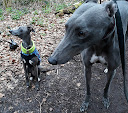Skeinspotted! - Fake Knitting
Last night, I was watching My Name Is Earl on the TV. There was a scene with a woman knitting in bed, now I have never seen such hopeless fake knitting in my life! My partner who is a musician cringes with embarrassment when he sees a fake violin player or other fake musical instrument playing in films/TV. I feel exactly the same when the knitting is just not real and even more so when it is supposed to be a cliche granny thing.
 I know it shouldn't matter, but this reinforcing of stereotype has led to some family and friends thinking that knitting is not a proper job and that somehow my qualifications and skills are wasted. However, many do respect my work and that really counts too.
I know it shouldn't matter, but this reinforcing of stereotype has led to some family and friends thinking that knitting is not a proper job and that somehow my qualifications and skills are wasted. However, many do respect my work and that really counts too.
Here is an amusing pic of another fake knitter! We all fell for that gag didn't we?
 I know it shouldn't matter, but this reinforcing of stereotype has led to some family and friends thinking that knitting is not a proper job and that somehow my qualifications and skills are wasted. However, many do respect my work and that really counts too.
I know it shouldn't matter, but this reinforcing of stereotype has led to some family and friends thinking that knitting is not a proper job and that somehow my qualifications and skills are wasted. However, many do respect my work and that really counts too.Here is an amusing pic of another fake knitter! We all fell for that gag didn't we?









